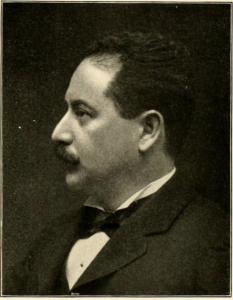
Photo info ...
Credit: Public domain via Internet ArchiveView Source
(May 31, 1857-Apr. 12, 1903). Nathaniel N. Morris was born in Coloma, California. His father was a native of Prussia (now part of Germany), and his mother was born in England. His parents married in 1845 and emigrated to the United States in 1847. They initially lived in New York City, but the 1849 California Gold Rush lured them to Coloma, the mining town 36 miles northeast of Sacramento which grew around Sutter’s Mill where the gold was first found. New mining opportunities, which the discovery of the Comstock Lode (a rich deposit of silver) made possible, led the Morris family to move to Virginia City, Nevada, in 1859.
Morris first attended the Virginia City public schools. Dissatisfied with the education he was receiving there, his parents sent him to a school in New York. In 1871, Morris joined his family in Indianapolis, where his father had moved to become a real estate agent for the Atchison, Topeka & Sante Fe R. R. Co. lands. To create demand for its services, the railroad set up real estate agencies to sell farmland in Kansas that was included in the land grants awarded to it by Congress.
By 1874, Morris was working for McKeon and Ruffini, a wood engraving company. He left McKeon and Ruffini, in 1875, to read law in the office of General George H. Chapman, an Indiana Civil War general and prominent judge and attorney. He also enrolled in and graduated from the Central Law School, an early Indianapolis proprietary school (see ). He was admitted to the bar in 1877 and joined Chapman’s firm. After Chapman died in 1882, he became a founding partner of Morris, Newberger & Curtis, known as a pioneer corporate and commercial law firm in the state.
He served as the first president of the and was a close colleague of President . For a time, he was a circuit court commissioner for the U.S. District Court of Indiana. In this position, he took special bail and affidavits in civil actions processed by the state’s U.S. District Court (See ). He also was a member of the committee that examined applicants for admission to the bar of the United States courts in the Indiana District.
Morris died prematurely while attempting to rescue his sister, brother-in-law, and their children from their burning home on North Alabama Street. Everyone survived the fire except for Morris and his nephew.
At the time of his death, the New York Times identified Morris as “one of the best-known” attorneys in Indiana, and the Indianapolis Bar Association adopted a resolution that recognized him. Prominent Jewish women founded the Nathan Morris House in 1904 to honor his life of service and heroic death. The settlement house served Jewish immigrants who had newly arrived in Indianapolis plus the immigrant poor of the south-side . The incorporated it into its operations, and it became the center for its social and educational facilities. It evolved into what is known as the , which was established in 1914.
In 1909, a group of lawyer colleagues presented the Nathan Morris Memorial Fountain, installed at the triangle between Park and Walnut streets and . The fountain included a trough for horses on two sides and a drinking fountain for people on two sides. The fountain fell into disrepair and disuse in the 1930s, once the automobile overtook horses as transportation, and no longer exists.
Morris was a member of several charitable and civic organizations including , Americus Club, , , , , and University Club. At the time of his death, Morris had not married and did not have children.

Help improve this entry
Contribute information, offer corrections, suggest images.
You can also recommend new entries related to this topic.